Three major air disasters in 1994 set warning lights flashing throughout the Air Force about safety procedures. First, an F-16 crashed into two transports at Pope AFB, N.C., destroying the fighter and one transport and killing twenty-three service members. Next came the accidental shootdown by two F-15s of two US Army UH-60 Black Hawk helicopters over Iraq, killing twenty-six personnel. Finally, a B-52 performing unauthorized maneuvers crashed near Fairchild AFB, Wash., killing four.
At that time, few members of the public would have guessed that the Air Force safety record was not deteriorating.
These tragedies by themselves would have been enough to trigger a review of USAF procedures, but Alan Diehl, a former safety official at Air Force Safety Center, Kirtland AFB, N.M., added to the urgency by writing a scathing letter to the Defense Secretary and members of Congress. In it, he charged that a lack of independence and expertise on Safety Investigation Boards (SIBs) had compromised as many as thirty crash probes.
Nowhere did those warning lights flash more intensely than at Kirtland AFB, where Air Force Safety Center officials chart accident trends in an effort to prevent mishaps. “That letter and those three high-profile accidents attracted a lot of negative press, and I had a lot of my own concerns,” said Brig. Gen. Orin L. Godsey, the Air Force chief of Safety.
| DoD’s Class A mishap rate, calculated as the number of accidents per 100,000 flying hours, declined from about 4.3 in FY 1975 to 1.5 in FY 1995. | 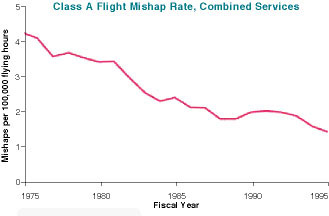 |
These events touched off a series of high-level investigations by an Air Force Blue Ribbon Panel on Aviation Safety, the General Accounting Office, and the Pentagon Inspector General. General Godsey said that the work of the Blue Ribbon Panel was important “to get at the truth behind the accidents.” However, he added, “I was trying to put out the positive message that our overall accident record was still good. I was just never effective at cutting through the negative spin.”
The Reality
Then, in February 1996, GAO released a report titled “Military Aircraft Safety: Significant Improvements Since 1975.” GAO investigators confirmed what USAF safety officials knew all along–that Air Force safety had been improving for many years.
From Fiscal 1975 through 1995 the annual number of Class A mishaps (those involving a fatality, loss of aircraft, or damage worth $1 million or more) for all services decreased from 309 to seventy-six. Air Force Class A mishaps dropped from ninety-nine to thirty-two. The mishap rate–or the number of Class A mishaps per 100,000 flying hours–dropped from about 4.3 to 1.5 for the military as a whole and from 2.8 to 1.44 for the Air Force.
“I think everyone was a little surprised at those findings, and that may be a result of the so-called ‘CNN effect,’ where we pay more attention to these accidents because they now attract more national news,” said William E. Beusse, assistant director for GAO’s Military Operations and Capabilities group.
GAO noted that each of the services has taken steps to reduce aviation mishaps, including tracking mishap-investigation recommendations and disseminating safety information in manuals, newsletters, and videos. As noted in the GAO report, the Air Force has also recently instituted a number of reforms to enhance the independence of its investigations.
|
Each of the services has also experienced an overall downward trend in its mishap rate since FY 1975. | 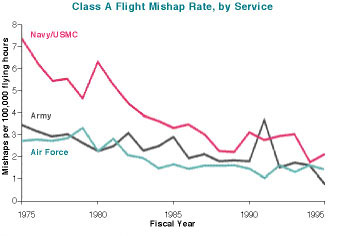 |
|
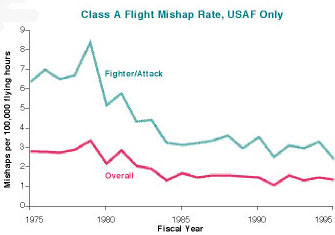 |
The Blue Ribbon Panel, which released its report in September, tracked similar improvements in safety since 1975. It found, for instance, that Class A mishaps for fighter/attack aircraft have fallen by 61.5 percent over the past two decades, while aircraft losses and fatalities have been reduced by 51.7 percent and 62.7 percent, respectively.
The panel also noted a perception–even among those involved–that SIBs lacked full independence.
“Notwithstanding [an] overall positive perception regarding the mishap-investigation process, there are too many service members who believe that SIB results are occasionally driven by factors outside of the [SIB] process,” the panel’s report stated, citing information from a questionnaire developed by the Air Force Military Personnel Center (now the Air Force Personnel Center, after merging with the Air Force Civilian Personnel Management Center). “The fact that a significant portion of those holding these views have had SIB experience is an important consideration in developing recommendations.”
Previously, a commander of a numbered air force had the authority to convene an SIB, choosing members from within the numbered air force. Once the SIB investigation was completed, the commander could make changes to the language of the report before it was formally released.
“I think the Air Force realized that no matter how well-intentioned commanders were, it just didn’t look right . . . that they could change the language of an accident investigation report and no record would exist of the original,” said GAO’s Mr. Beusse. “People should be able to make up their own minds on the legitimacy of the changes.”
The panel concluded that, in order to remove the perceived conflict of interest, the authority to convene an SIB should rest solely with the commander of the major command (Majcom) involved. The panel also recommended that the SIB report precisely reflect the results of the investigation.
Three Options
“So,” said General Godsey, “once a Majcom commander is briefed on the SIB report, he has three options: He can concur, concur with his own comments added, or . . . tell the board to go back and reinvestigate if he thinks they missed something. What he can’t do is change the report, and the purpose of that was to remove even the perception in anyone’s mind of bias or a cover-up.”
Even after an SIB report clears the Majcom, it is subjected to a thirty-day review by the Air Force Safety Center. During that review, the director can reopen an investigation. “That’s actually happened twice during my tenure, because I’ve received letters during my review that alleged that pertinent information had been missed,” said General Godsey.
|
The number of DoD aviation fatalities per 100,000 flying hours fell from about four in FY 1975 to about 1.7 in FY 1995. | 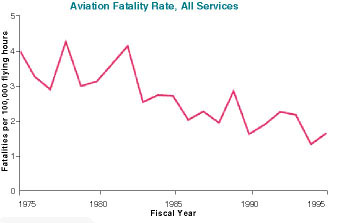 |
|
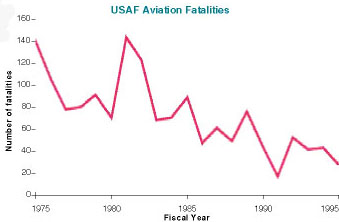 |
The Air Force has also adopted a number of the panel’s recommendations aimed at improving the expertise on SIBs. An Air Force Safety Center representative who sits on all Class A investigation boards, for instance, was elevated to the status of a voting member. The Air Force also declared that, after October 1, 1995, all SIB leaders would have to take and pass a board president’s course. The center has expanded the number of courses designed to train board members to ensure that Majcoms will have adequate expertise on staff.
“That’s a positive development for two reasons,” said General Godsey. “First, we all agreed that someone shouldn’t be on an investigation board unless he was adequately trained, but often there just weren’t sufficient courses available.” He continued, “Because the people sent to these courses are also the same ones responsible for instituting safety programs for the wings and squadrons, we get a prevention benefit as well.”
The Blue Ribbon Panel specifically rejected suggestions, however, that the Air Force create a totally independent accident investigation organization modeled after the National Transportation Safety Board. While the Federal Aviation Administration regulates commercial and general aviation, accident reports are conducted only by independent NTSB investigators.
Panel members concluded that such adversarial “second guessing” of the chain of command could harm combat readiness.
“We want the Majcom commander to ‘buy in’ to the safety program, and that’s much more likely to happen if he can appoint his own team,” said General Godsey. “He also has the same goal of zero mishaps or fatalities; so to imply that this four-star general would want to cover up the cause of an accident is really insulting to his integrity.”
Looking Deeper
With board members more thoroughly trained in accident-investigation techniques, Air Force officials hope SIB reports will also get at the possible underlying causes for a disaster. Too often, they say, sterile SIB reports focus on the most obvious causes without digging further into possible unseen contributors.
For example, when an E-3B Sentry Airborne Warning and Control System aircraft crashed near Elmendorf AFB, Alaska, last year [see “Leadership Lapse Cited in AWACS Crash,” “Aerospace World,” p. 21], the ingestion of geese by the aircraft’s engines was cited as the primary cause of the accident. “But what led so many geese to be flying near one of our airfields?” asked General Godsey. “Those are the kinds of indirect causes of accidents that we want to highlight in our reports.”
|
Since FY 1975, the annual rate of estroyed aircraft per 100,000 flying hours has dropped from 3.1 to 1.3. | 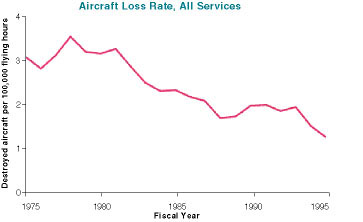 |
|
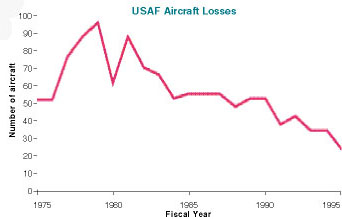 |
In another incident last year, an Air Force helicopter crashed into a cable during night vision flying in Korea. The direct cause of the accident was obvious, but Safety Center officials dug a little further to unearth fundamental “human factors” problems.
“We found that the unit had only recently transitioned to that type of helicopter, and the fact that they were being pushed very hard in training to get them combat-ready in a hurry was clearly a contributing factor,” said General Godsey. “So, in the past, there has been a tendency to want to blame the machine rather than the man. Yet, in a lot of our mishaps, the man has been just as responsible as the machine.”
GAO’s analysis of data reported by all services showed that human error contributed to seventy-three percent of Class A flight mishaps in Fiscal Years 1994 and 1995. In Air Force mishaps, human error was a factor seventy-one percent of the time. For the Army, the figure was seventy-six percent. According to the Naval Safety Center, human error was a factor in eighty percent of the Navy and Marine Corps Class A mishaps for Fiscal Years 1990 through 1994.
“The fact that nearly three-fourths of accidents have a human error factor doesn’t necessarily mean that the human caused the problem,” said GAO’s Mr. Beusse. “Often, some other problem occurs, but at some point the human could have or should have intervened to change the course of events–and that someone is not always the pilot. It could be anyone from the air traffic controller to the maintenance crew.”
That point was tragically highlighted in May 1995, when an F-15 pilot was killed shortly after takeoff from Spangdahlem AB, Germany. Two Spangdahlem mechanics are standing trial for negligent homicide as well as four counts of dereliction of duty. According to Air Force officials, one mechanic failed to install two flight-control rods properly, rendering the fighter uncontrollable. The other mechanic allegedly failed to catch the mistake in a required inspection. [See “F-15 Mechanics Stand Trial,” May 1996 “Aerospace World,” p. 30.]
Human Factors
To avoid such human errors, all of the services have implemented human factors programs designed to manage and reduce aviation risk. The whole field of human factors got a big boost from the space program, when psychologists for NASA studied ways to improve safety in flight operations.
In 1993, the Air Force established a Crew Resource Management Steering Group. The next year, CRM training programs were required for all Air Force crew members. According to the Blue Ribbon report, however, implementation of the CRM programs was held up by staff reductions resulting from the military drawdown of the 1990s.
“Not all of the Air Force community adopted CRM as they should have, and the Air Force has recently made the director of Operations and Plans the CRM advocate,” said General Godsey, who notes that the Air Combat Command recently let a contract to introduce CRM into the fighter arena.
The CRM program, he said, can improve interaction and communication in any crew environment, from multimember bomber crews to single-member fighter crews to a two-member maintenance team changing a tire on the flight line. “We look at human factors as the next pearl that, when polished, will help us reduce our mishaps,” he said.
| The services put the cost of Class A flight mishaps since 1975 at about $21 billion. The value of Class A losses has been fairly constant over the last six years, ranging from a high of approximately $1.6 billion in FY 1993 to a low of $1.2 billion in FY 1994. | 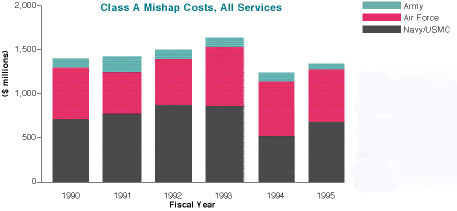 |
The Air Force and Navy both are also interested in an Operational Risk Management program instituted by the Army. After suffering a disproportionate number of OH-58 helicopter accidents at night, the Army developed a series of flight profiles for predicting whether a mission was low, medium, or high risk. The number of accidents dropped off once a system was developed to assess the risk prior to each OH-58 mission and offer guidance for reducing the risk to acceptable levels. The Army plans to expand use of the risk-management system to include not only other aircraft but also ground vehicles.
“What we want to do is formalize risk management into our education and training programs,” said General Godsey, “so from the time someone comes into the Air Force, they are indoctrinated into a risk-management culture. Of course, as the Air Force moves from peacetime to contingency operations to wartime, you’ll see the amount of risk people are willing to take rise.”
Getting airmen to consider risk carefully, however, is far different from asking them to avoid it. That would go against the grain, experts say, of an organization that has to respect, and in some cases revere, the reasoned risk-taker.
“You want to allow pilots to train hard enough to get a good feel for what their aircraft can do, while at the same time keeping them from getting so close to the edge during training that they significantly increase the danger of a crash, with its attendant loss of life and very expensive equipment,” said Mr. Beusse. “In a sense, risk management is an attempt to protect pilots from themselves. These tend to be very motivated, dedicated people. Sometimes they have so much confidence in the aircraft and their own abilities that they push that envelope a little too far.”
| Crash Kills Thirty-Five, Including Commerce Secretary
In the military’s most recent high-profile air accident, a USAF CT-43A passenger jet crashed on April 3 at Dubrovnik, Croatia, killing Commerce Secretary Ronald H. Brown and thirty-four others. The cause of the crash was not readily apparent and raised concerns that the lack of “black boxes” on the military jet would hamper the investigation. Although the weather was poor and the airport had only a rudimentary radio beacon, DoD officials stated that the flight was within commercial passenger aircraft restrictions. Extensive review of the wreckage by military and civilian investigators has already ruled out rudder and other major equipment failures, according to senior USAF officials. DoD expects to issue a more complete report this month. The accident prompted Defense Secretary William Perry on April 9 to order each service to install cockpit voice and flight-data recorders, as well as Global Positioning System equipment for precise navigation, as soon as possible on all military aircraft that carry passengers. He also directed the service secretaries to report to him on passenger-manifesting procedures because of the initial confusion over the number and identity of persons aboard the CT-43. The aircraft, a military version of the Boeing 737-200, crashed into Saint John’s Hill, a 2,300-foot peak about 1.8 miles northwest of Dubrovnik’s Cilipi Airport. The transport had been flying in what some officials termed the worst storm in a decade, but the aircraft commander, Capt. Ashley J. Davis, and the copilot, Capt. Timothy W. Schafer, both had substantial experience with the aircraft. They were making an instrument approach using the airport’s single radio beacon. The CT-43 was on the correct approach path as it started a twelve-mile-long descent to the airport, according to radar data collected by one NATO aircraft, and it was communicating with the airport tower when contact suddenly was lost. USAF Lt. Gen. Howell M. Estes III, Pentagon Operations chief, said the crew made no calls indicating there was a problem. Several commercial aircraft had landed at the airport shortly before the USAF jet made its approach. However, the Washington Post reported that Croatian Airlines had diverted some of its flights because of the harsh weather. The CT-43 #1149 was one of two used for passenger transportation, while another fifteen are used for navigation and cargo training. USAF officials said this was the first crash for any of its T-43s in 300,000 flying hours during more than twenty years of service. With only 17,000 flying hours, this particular aircraft was well short of the 30,000 to 50,000 flying-hour average for other T-43s of that age. General Estes noted that this CT-43, operated by the 86th Airlift Wing, Ramstein AB, Germany, had undergone an extensive maintenance overhaul in June 1995. The aircraft entered operation in 1973, the year before USAF began its policy of equipping its aircraft with cockpit voice and flight data recorders. USAF officials stated that the aircraft was used for training until 1988 and was not retrofitted with black boxes because of the expense. At a briefing April 9, a senior USAF official also said that the T-43s were the only passenger aircraft without such recorders. Although black boxes are standard today on commercial airliners, the National Transportation Safety Board (NTSB) has not been able to resolve two recent commercial 737 crashes. More than 2,700 Boeing 737s are in service, making it one of the world’s most widely used airliners. It has also been one of the safest. The unresolved crashes, however, have caused the NTSB to focus more closely on any 737 crash. The senior Air Force official said that although the lack of recorders would “complicate” the CT-43 investigation, with today’s technology the service will “be able to replicate almost the entire realm” of the flight and the lack of black boxes “will not preclude us from finding out what happened in the mishap.” The NTSB and Federal Aviation Administration are working with the Air Force Accident Investigation Board, headed by Brig. Gen. (Maj. Gen. selectee) Charles H. Coolidge, Jr., 22d Air Refueling Wing commander, McConnell AFB, Kan. —Suzann Chapman |